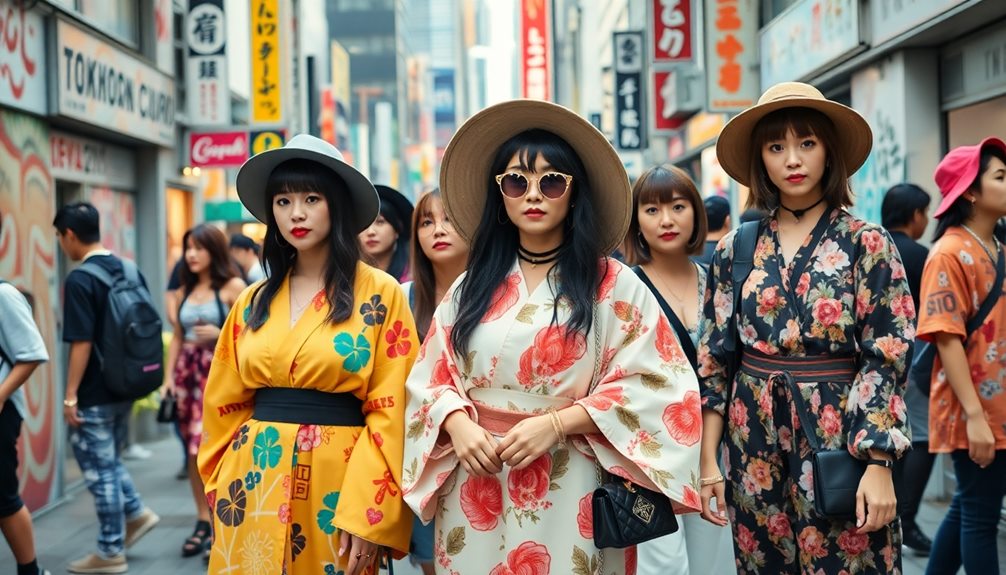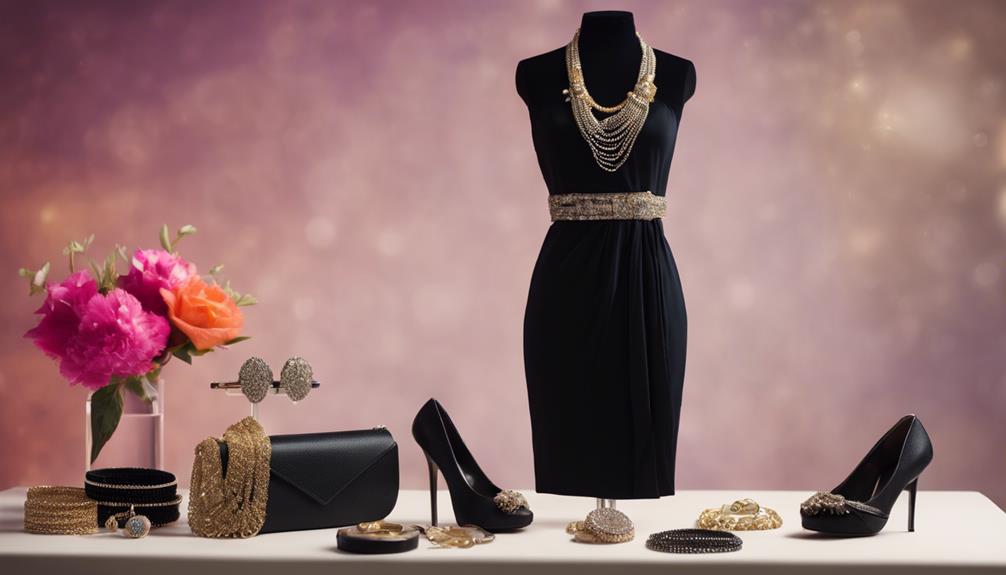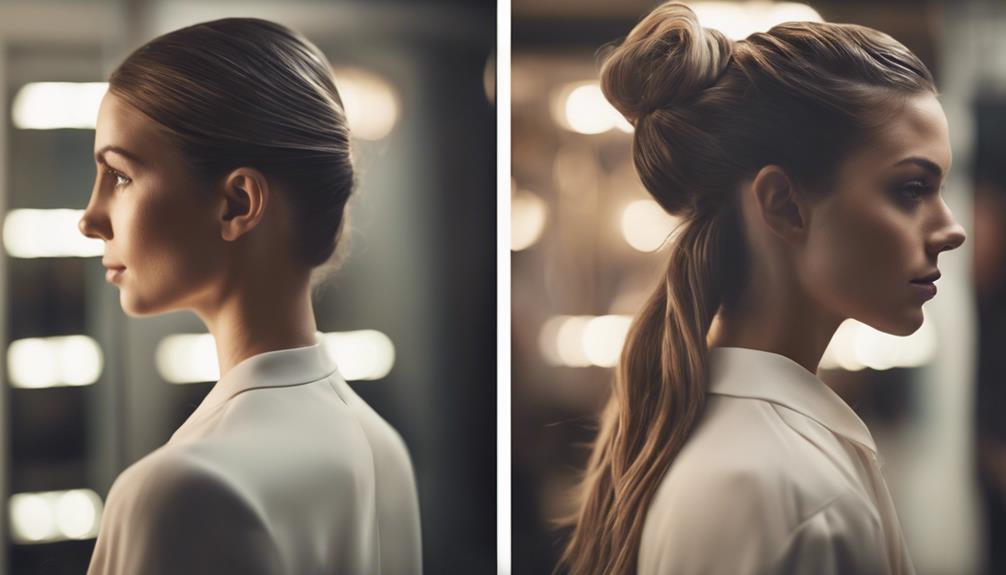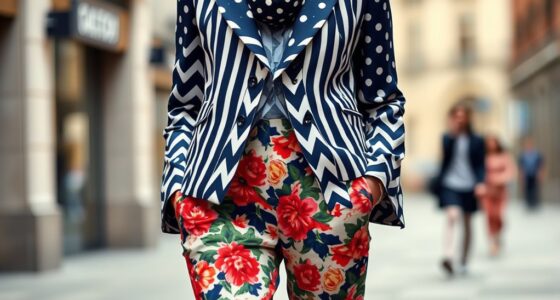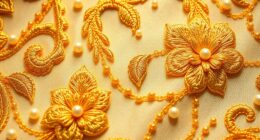Japanese street style has dramatically influenced global fashion trends by blending traditional elements with modern aesthetics. You'll find inspiration from subcultures like Harajuku, Kawaii, and Visual Kei, each offering bold colors and unique silhouettes. Designers like Rei Kawakubo and Yohji Yamamoto challenge norms, while brands like BAPE redefine streetwear. This cultural cross-pollination encourages innovation and collaboration, enriching fashion worldwide. The rise of anime and sustainable practices further amplifies this impact. As you explore these trends, you'll uncover the deeper connections shaping the future of fashion and the exciting directions it's heading.
Key Takeaways
- Japanese street style, particularly from Harajuku, introduced bold colors and eclectic layering, influencing global fashion aesthetics.
- Subcultures like Kawaii and Visual Kei redefined beauty standards, promoting unique and diverse expressions in modern fashion.
- Influential designers such as Rei Kawakubo and Yohji Yamamoto challenged conventional silhouettes, inspiring international designers with avant-garde styles.
- The fusion of traditional motifs with contemporary designs in Japan has reshaped global fashion narratives, emphasizing cultural appreciation.
- Anime and manga's vibrant aesthetics have permeated urban fashion, inspiring character-driven trends and collaborations across the globe.
Historical Roots of Japanese Fashion
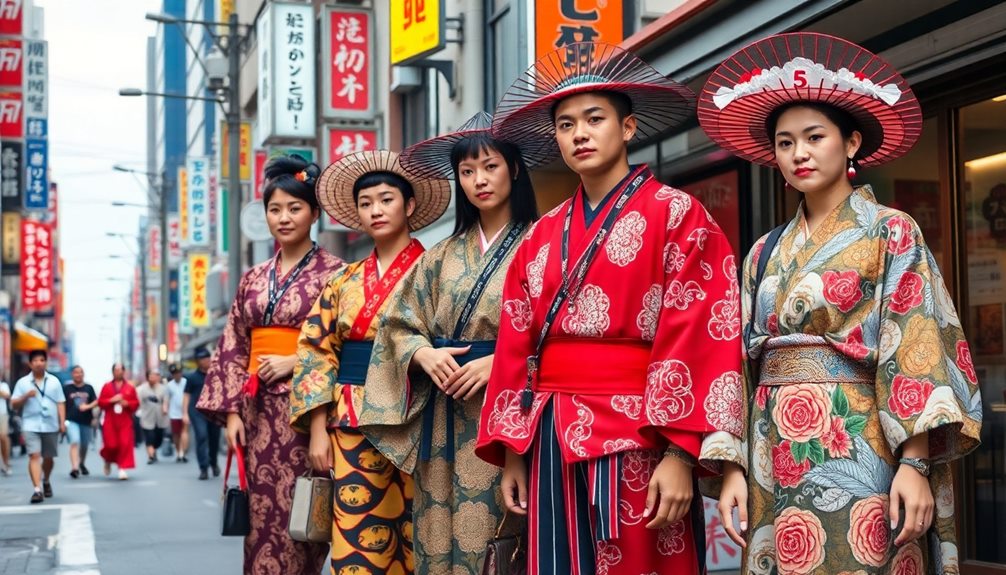
Japanese fashion has deep historical roots that intertwine traditional elements with modern influences, creating a unique cultural tapestry. Emerging in the post-war era, Japanese street fashion began to blend Western styles with local traditions, marking a notable cultural shift in the 1950s and 60s. You can see this fusion reflected in the avant-garde designs that showcase traditional motifs, revealing Japan's rich cultural heritage.
The Harajuku district became a vibrant hub for fashion experimentation in the 1980s, where young people explored bold and eclectic styles. Subcultures like Kawaii, Gyaru, and Visual Kei flourished, each promoting distinct aesthetics and philosophies. This open-minded approach to self-expression pushed boundaries and encouraged individuality, making a lasting impact on global fashion.
Influential designers such as Rei Kawakubo and Yohji Yamamoto played key roles in this movement, introducing innovative designs that challenged norms and showcased androgyny. Their contributions not only highlighted Japan's unique fashion identity but also notably influenced global trends.
As you immerse yourself in Japanese street fashion, you'll discover how deeply ingrained cultural elements continue to inspire and shape the ever-evolving landscape of fashion worldwide.
Key Styles and Subcultures
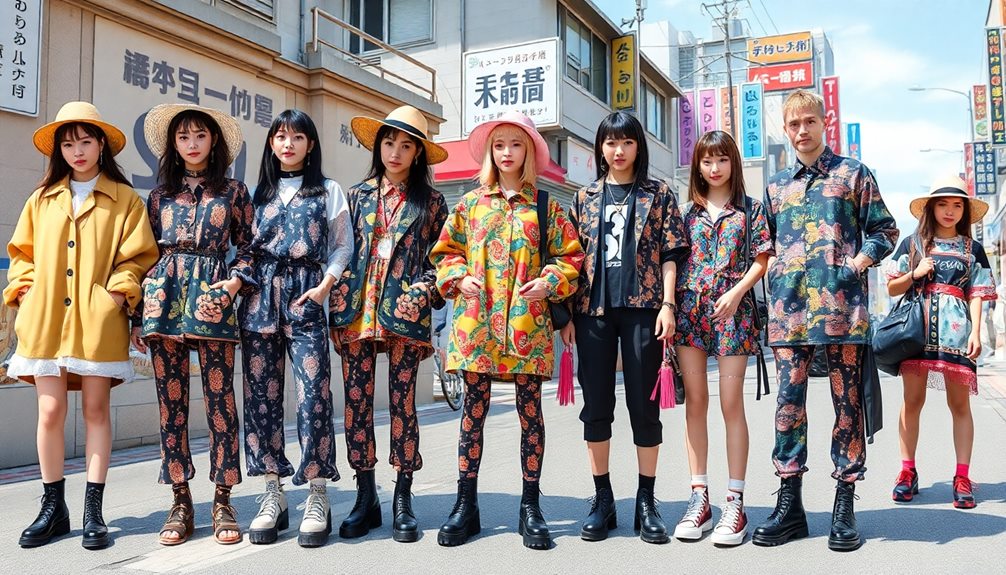
The vibrant landscape of Japanese fashion is defined by its diverse styles and subcultures, each offering a distinctive lens through which to view self-expression. From the playful aesthetics of Harajuku style to the dramatic flair of Visual Kei, these trends celebrate individuality and the eclectic nature of street fashion in Japan.
Here's a quick overview of some key styles:
| Style | Description |
|---|---|
| Harajuku Style | Bold colors, layering, and unconventional accessories. |
| Kawaii Subculture | Emphasizes cuteness with pastel colors and playful motifs. |
| Gyaru Style | Features tanned skin, extravagant hairstyles, rejecting traditional beauty. |
| Visual Kei | Androgynous clothing and dramatic makeup influenced by rock music. |
| Gothic Lolita & Decora | Gothic Lolita focuses on Victorian-inspired outfits, while Decora highlights colorful accessories and layering. |
These subcultures reflect Japan's cultural emphasis on innocence, youth, and diverse expressions of femininity. Each style contributes to a rich tapestry of fashion that continues to inspire global trends, showcasing how street fashion in Japan encourages creativity and personal identity.
Current Trends in Streetwear
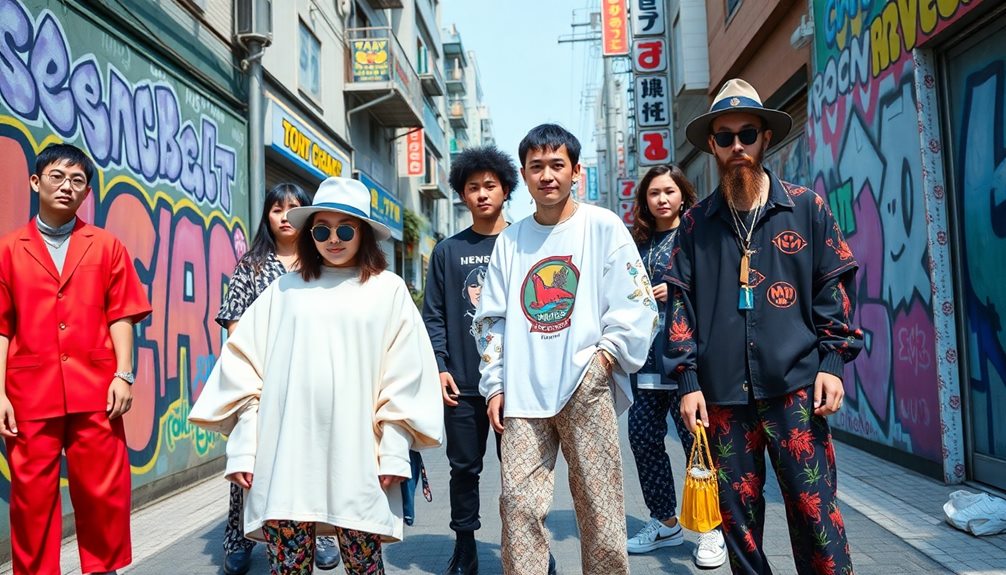
Streetwear today showcases a fusion of comfort and innovation, with oversized silhouettes and dynamic layering techniques taking center stage. This contemporary streetwear reflects the essence of Japanese street style, embracing the wabi-sabi philosophy that values simplicity and natural forms. In addition to the oversized silhouettes, streetwear enthusiasts are also experimenting with fresh white jeans outfit ideas, incorporating them into their daily looks for a clean and modern aesthetic. The versatility of white jeans allows for endless styling possibilities, from pairing them with graphic tees and chunky sneakers for a casual look, to dressing them up with a tailored blazer and loafers for a more sophisticated ensemble. This intersection of comfort and style in contemporary streetwear has sparked a new wave of creativity and self-expression in the fashion world.
Here are some current trends you should watch:
- Oversized Clothing: Comfort reigns supreme as baggy fits dominate the scene, allowing for freedom of movement.
- Techwear: Combining futuristic aesthetics with functionality, techwear features water-resistant fabrics and modular designs for active lifestyles.
- Sustainable Fashion: With a growing focus on upcycling and second-hand shopping, vintage styles are making a comeback, promoting environmental awareness.
- Anime Influence: Graphic styles and character motifs inspired by anime and manga are becoming popular, letting fans express their cultural affinity.
Minimalism also remains strong, characterized by clean lines and neutral palettes, often enhanced by unique details like asymmetrical cuts.
These trends not only showcase individual expression but also highlight a global movement towards conscious fashion choices, drawing inspiration from diverse sources while shaping the future of streetwear.
Influential Designers and Brands
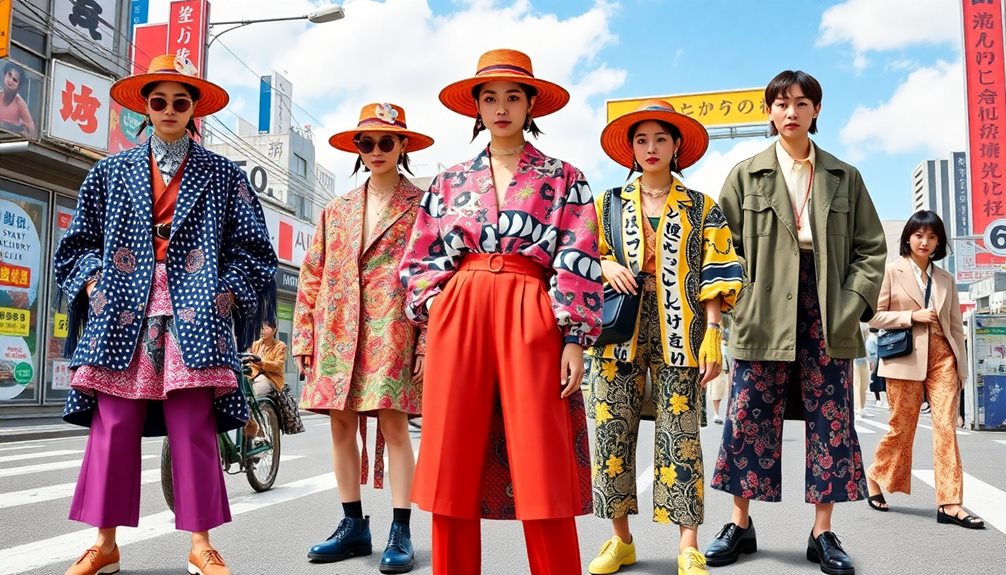
Innovation in fashion often springs from the visionary minds of influential designers and brands that push boundaries and redefine norms. Japanese designers like Rei Kawakubo and Yohji Yamamoto have been at the forefront of this movement, each bringing a unique perspective that has shaped global fashion.
Kawakubo's avant-garde designs challenge conventional silhouettes, while Yamamoto's blend of minimalist aesthetics and Western tailoring creates an unmistakable style that resonates with fashion enthusiasts worldwide. The resilience and strength reflected in Japanese fashion can be compared to the Tiki Figures in Polynesian culture, symbolizing protection and guidance through innovative design.
A Bathing Ape (BAPE) revolutionized modern streetwear with its urban-inspired clothing and iconic camouflage patterns, making it a staple brand in both Japanese and global fashion scenes.
The global impact of Japanese fashion extends beyond individual brands, as seen in collaborations like Hiroshi Fujiwara's Fragment Design with Nike, showcasing the versatility of Japanese aesthetics.
Brands like MUJI and Uniqlo further exemplify this influence, focusing on minimalist sophistication and quality, which appeal to consumers seeking versatile wardrobe staples.
This cultural cross-pollination not only enriches street style trends but also invites a broader appreciation for the creativity and innovation stemming from Japan, ultimately redefining the global fashion landscape.
Cultural Heritage and Modernity
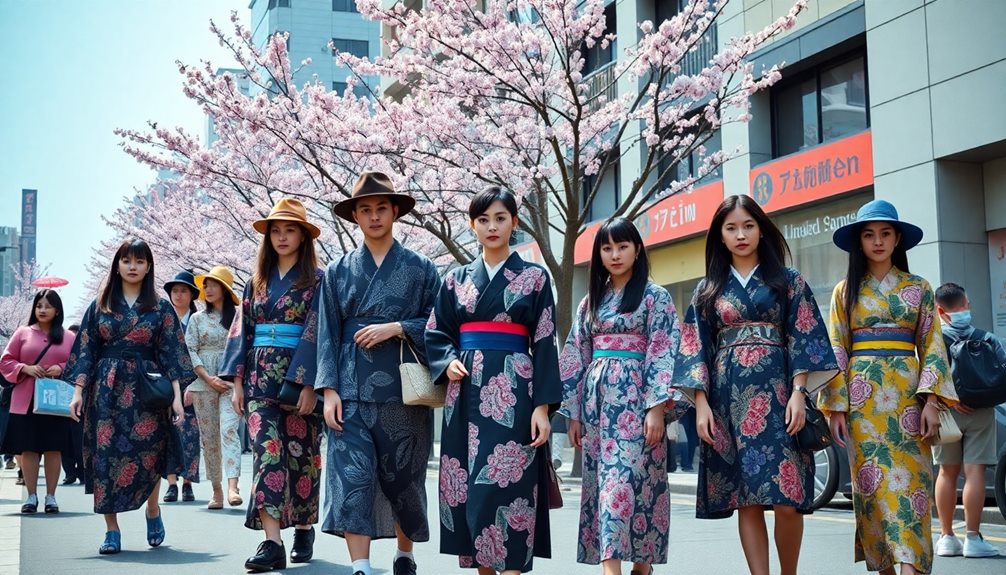
Blending cultural heritage with modernity, Japanese street fashion creates a dynamic landscape that celebrates tradition while embracing contemporary influences. This unique style is particularly evident in the vibrant Harajuku district, where youth culture thrives on eclecticism and innovation.
Here are some key aspects of this cultural fusion:
- Traditional Motifs: Japanese street fashion often incorporates traditional motifs, like kimono patterns, into modern outfits, showcasing a seamless blend of old and new while reflecting the importance of risk-taking in innovation.
- Subcultures: Styles such as Kawaii and Visual Kei reinterpret traditional aesthetics, with cuteness and androgyny manifesting in creative, expressive ways.
- Resurgence of Kimonos: The revival of kimonos in streetwear illustrates a respect for cultural heritage, allowing individuals to express personal style while honoring tradition.
- Influential Designers: Designers like Rei Kawakubo and Yohji Yamamoto have merged Wabi Sabi principles with contemporary designs, emphasizing beauty in imperfection and pushing the boundaries of conventional fashion.
This mix of cultural heritage and modernity not only defines Japanese street fashion but also influences global trends, encouraging a new appreciation for diverse aesthetics.
Sustainability in Fashion Practices
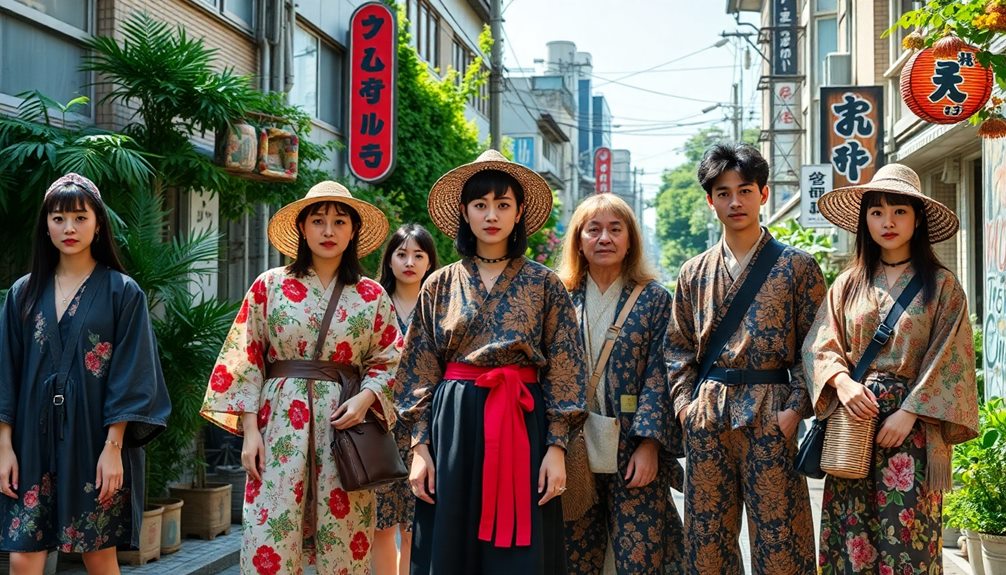
Cultural heritage and modernity in Japanese street fashion pave the way for a growing focus on sustainability within the industry. You'll notice how designers increasingly use recycled materials and upcycled textiles, creating stylish apparel that minimizes waste and lowers carbon footprints.
The slow fashion movement, which originated in Japan, emphasizes quality over quantity. By investing in durable, timeless pieces, you contribute to a more sustainable future and break free from the cycle of fast fashion. Additionally, incorporating nutrient-dense ingredients like chia seeds into your diet can enhance your overall well-being, mirroring the mindful consumption advocated in sustainable fashion practices, such as promoting nutritional power through plant-based diets.
Moreover, traditional techniques like kimono weaving and indigo dyeing are making a comeback. These practices not only promote sustainability but also preserve cultural heritage, reducing the reliance on synthetic materials.
As you explore Japanese fashion, you'll find a commitment to eco-friendly practices, including the use of natural dyes and transparent supply chains. This transparency builds consumer trust, ensuring that your choices align with sustainable initiatives.
Lastly, the resurgence of vintage shopping reflects a broader global trend. By seeking unique styles through thrift shops, you support eco-conscious practices while reducing waste.
Embrace these sustainable practices in your wardrobe, and you'll be part of a movement that values both heritage and responsibility.
Global Influence and Collaboration
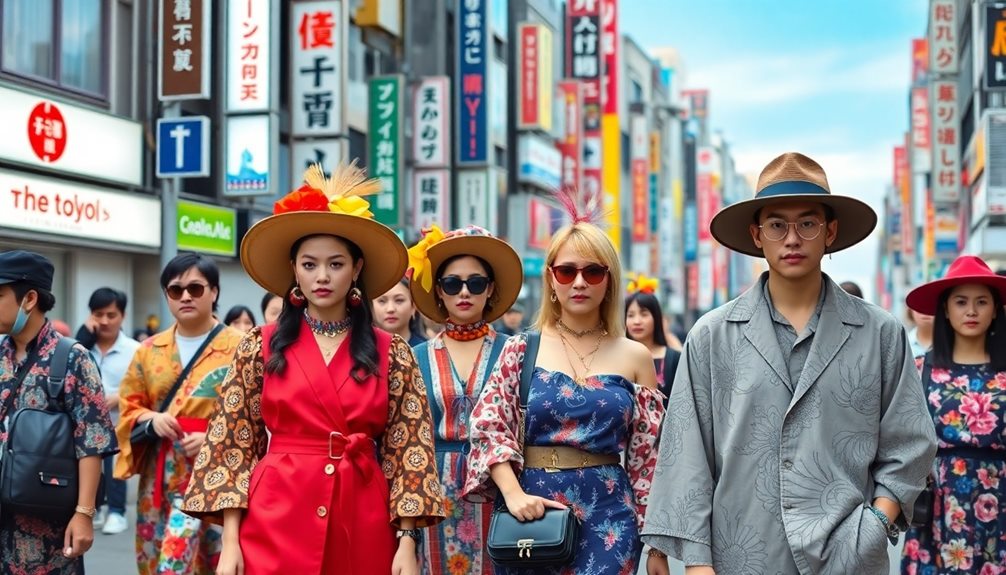
Japanese street fashion has become a global phenomenon, enchanting audiences far beyond the Harajuku district. This cultural cross-pollination has led to a significant global influence that's reshaping trends and styles.
Designers like Rei Kawakubo and Yohji Yamamoto brought avant-garde concepts and androgyny to Western fashion, inspiring a new generation of designers. The collaboration between Japanese brands and major Western labels, like A Bathing Ape (BAPE), has resulted in innovative collections that merge streetwear aesthetics with high fashion.
Here are some key aspects of this global influence and collaboration:
- Cultural Exchanges: Fashion events and social media platforms facilitate the sharing of ideas and styles across borders.
- Distinctive Subcultures: Elements from Japanese subcultures, such as Gyaru and Visual Kei, have been adopted into global street styles.
- Innovative Collaborations: Partnerships between designers lead to unique collections that blend Japanese motifs with contemporary trends.
- Diverse Expressions: The integration of these styles fosters a rich tapestry of fashion expressions worldwide.
This vibrant exchange not only enhances global appreciation for Japanese style but also continually evolves the fashion landscape.
The Role of Anime and Manga
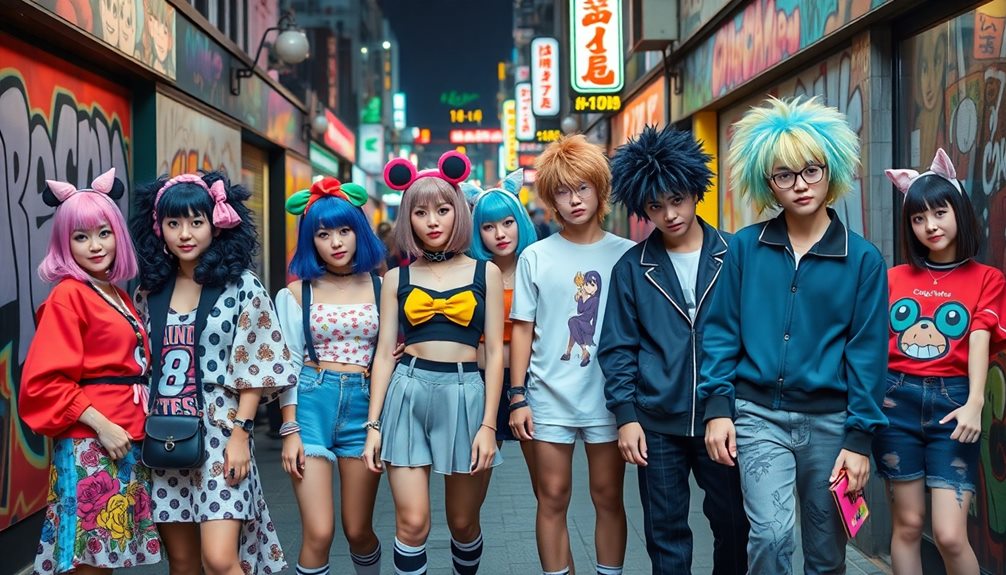
Anime and manga aren't just entertainment; they shape visual aesthetics and style in fashion today.
You've likely noticed how character-inspired trends from these mediums spark unique looks, especially in urban landscapes.
As global fan culture continues to grow, the influence of these art forms on mainstream fashion only gets stronger.
Visual Aesthetics and Style
While exploring the vibrant world of fashion, you'll quickly notice how visual aesthetics from anime and manga have woven themselves into everyday styles.
Japanese streetwear, with its unique flair, has embraced these influences, allowing fans to showcase their love for the art form through their clothing choices.
Here are some key elements that highlight this cultural crossover:
- Vibrant Colors: Bold, eye-catching hues reflect the lively palettes found in anime and manga, adding an energetic touch to outfits.
- Oversized Silhouettes: This trend mirrors the exaggerated proportions often seen in animated characters, offering both comfort and a playful edge.
- Bold Patterns: Inspired by graphic visuals from these mediums, streetwear often features striking prints that stand out in any crowd.
- Cultural Significance: Collaborations between fashion brands and anime/manga artists have resulted in limited-edition collections, emphasizing the deep-rooted connection between these artistic expressions and contemporary fashion.
These elements not only enhance individual style but also underline the growing influence of anime and manga on global trends, bridging cultural gaps through creative expression.
Character-Inspired Fashion Trends
Character-inspired fashion trends have taken the global streetwear scene by storm, blending playful motifs and bold graphics from beloved shows into everyday attire. As an anime fan, you've likely noticed how these trends have evolved, allowing you to express your passion through fashion.
The rise of cosplay has fueled this movement, encouraging designers to create clothing that mimics the outfits of iconic characters. This merging of pop culture and fashion is evident in collaborations between brands like UNIQLO and popular anime franchises, offering limited edition collections that celebrate your favorite characters.
The vibrant colors and exaggerated styles typical of anime have inspired designers worldwide to experiment with unconventional silhouettes and patterns. This creative freedom contributes to the eclectic nature of contemporary street fashion, making it exciting and fresh.
You'll find that character-inspired clothing has become a staple at fashion events, showcasing the seamless blend of traditional and modern aesthetics rooted in Japanese street style. This cultural cross-pollination not only enriches your wardrobe but also connects you to a global community that shares your enthusiasm for anime and fashion.
Global Fan Culture Impact
With the rise of global fan culture, anime and manga have become powerful influences on fashion, shaping trends that resonate with diverse audiences.
You can see how these cultural phenomena have impacted streetwear designs and personal style in several ways:
- Vibrant Graphic Styles: Japanese fashion enthusiasts incorporate bright, recognizable designs from anime and manga into their outfits, making bold statements.
- Iconic Character Apparel: Clothing lines inspired by popular characters allow fans to express their love for these franchises, merging fandom with fashion.
- Events and Cosplay: Events like Anime Expo and Comic-Con showcase the intersection of anime/manga and fashion, where cosplaying becomes a canvas for unique personal styles.
- Collaborations and Social Media: The global reach of anime has fostered collaborations between Japanese brands and international labels, while social media platforms help spread these trends, creating a diverse fashion landscape.
Future Directions in Fashion
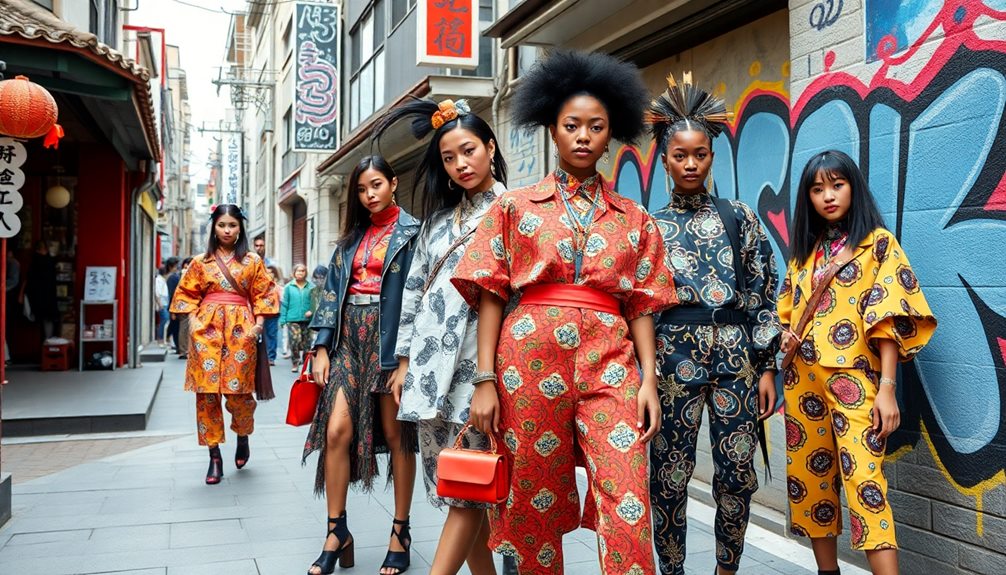
As you explore the future of fashion, you'll notice a strong push towards sustainable innovations that prioritize eco-friendly materials and ethical practices.
At the same time, technology is reshaping the landscape with smart fabrics and wearable tech that enhance both style and functionality.
These trends not only reflect evolving consumer values but also pave the way for a more personalized and responsible fashion experience.
Sustainable Fashion Innovations
Sustainable fashion innovations are reshaping the industry, pushing boundaries and redefining consumer expectations. As you explore Japanese street style, you'll find that it embraces sustainable practices in exciting ways. Here are some key trends driving this movement:
- Eco-Friendly Apparel: Designers are utilizing recycled materials and natural dyes, markedly reducing waste and environmental impact.
- Slow Fashion Movement: A focus on quality over quantity leads to durable, timeless pieces that resonate with sustainable values.
- Local Production Methods: By supporting artisans and traditional techniques, brands minimize transportation emissions while promoting craftsmanship and cultural heritage.
- Upcycling: The trend of repairing and upcycling garments extends clothing lifecycles and encourages creative styling, allowing you to express your individuality.
Moreover, transparency in supply chains is becoming a hallmark of Japanese brands, fostering consumer trust and accountability.
Technological Integration Advances
The landscape of fashion is evolving rapidly, driven by technological advancements that merge style with innovation. You'll notice that Japanese streetwear is at the forefront of this movement, integrating smart textiles that adapt to environmental stimuli. These fabrics enhance both comfort and functionality, catering to your modern lifestyle.
Wearable devices are also becoming common in stylish garments, creating multifunctional pieces that serve not just a fashion statement. Additionally, 3D printing technology is revolutionizing bespoke clothing production in Japan, drastically reducing waste while offering personalized options. Innovative clothing features like moisture-wicking and temperature-regulating capabilities are now standard, enhancing the practicality of everyday wear without sacrificing aesthetics.
This blending of functionality and aesthetics in Japanese streetwear is inspiring global designers to adopt technology-driven innovations. Here's a quick look at some key advancements:
| Feature | Description | Impact |
|---|---|---|
| Smart Textiles | Fabrics that respond to environmental changes | Enhanced comfort and functionality |
| Wearable Devices | Integrated tech within clothing | Multifunctional fashion options |
| 3D Printing | Custom clothing production | Personalized fashion, reduced waste |
| Innovative Clothing Features | Moisture-wicking and temperature-regulating traits | Practicality meets high style |
Consumer Behavior and Trends
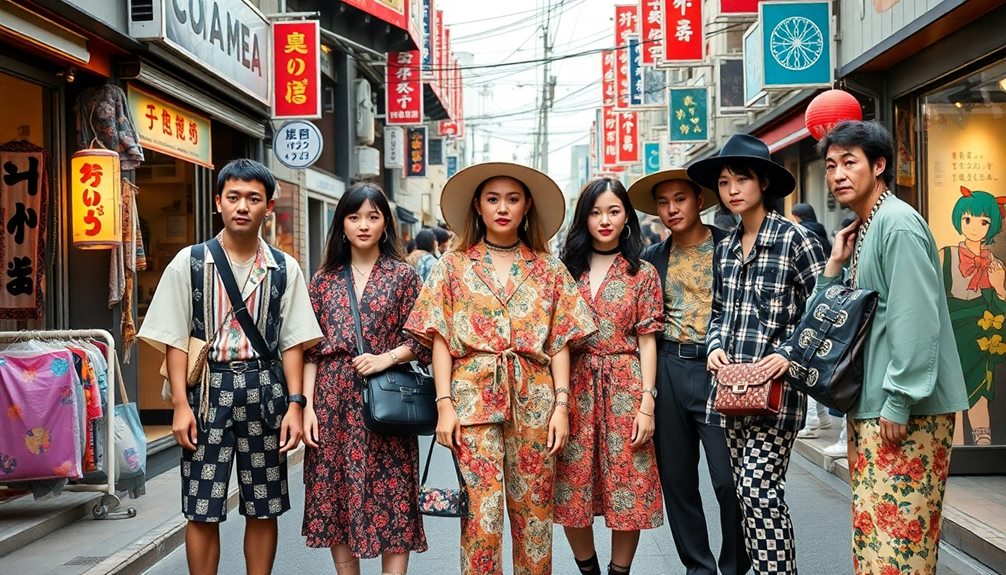
Fashion today is increasingly shaped by a consumer base that values individuality and ethical practices. You can see this shift in consumer behavior, where people prioritize unique styles over mainstream trends. The influence of Japanese fashion, particularly street style, has fueled this desire for eclectic and personal expression.
Here are some key trends shaping today's market:
- Sustainability: 66% of global buyers are willing to pay more for sustainable products, aligning with the ethical sourcing practices of many Japanese brands.
- Social Media Influence: Platforms like Instagram showcase unique outfits, driving demand for aesthetics inspired by Japanese street fashion.
- Gen Z Preferences: With 72% of Gen Z shoppers valuing eco-friendly practices, vintage and upcycled clothing are becoming increasingly popular.
- Collaborations: Partnerships between Japanese designers and international brands create limited-edition lines that attract global interest, enhancing cultural appreciation.
These factors illustrate how consumer preferences are evolving, making sustainability and distinctiveness central to contemporary fashion trends.
As you navigate this landscape, embracing these values can set you apart while aligning with what today's consumers truly desire.
Frequently Asked Questions
How Has Japanese Fashion Influenced Our World?
Japanese fashion's bold aesthetics inspire your wardrobe choices, encouraging you to experiment with vibrant styles and unique accessories. It also pushes you to embrace sustainable practices, shaping a more inclusive and environmentally conscious fashion landscape.
How Does Japanese Street Fashion Such as Harajuku Style Influence the Global Fashion Scene?
Japanese street fashion bursts like a kaleidoscope, showcasing vibrant styles that inspire you to embrace individuality. From bold colors to unique accessories, it pushes boundaries, reshaping global trends and inviting your creativity to flourish in fashion.
How Was Japan Influenced by International Trends?
You'll notice Japan embraced international trends post-war, blending American pop culture with local styles. The eclectic mix in areas like Harajuku showcases how global influences sparked unique fashion expressions among Japanese youth, fostering creativity and individuality.
How Does Street Style Influence Fashion?
They say style's in the eye of the beholder. Street style influences fashion by showcasing real people's creativity, sparking trends that challenge norms, and encouraging you to express your individuality through unique, eclectic looks.
Conclusion
Japanese street style isn't just a trend; it's a fashion revolution that's taken the world by storm! By blending historical roots with bold modernity, it's reshaped how we think about style and individuality. As you embrace these influences, remember that this cultural cross-pollination is only just beginning. The future of fashion is vibrant and dynamic, fueled by creativity and collaboration. So, keep your eyes peeled—who knows what stunning new trends are just around the corner?
